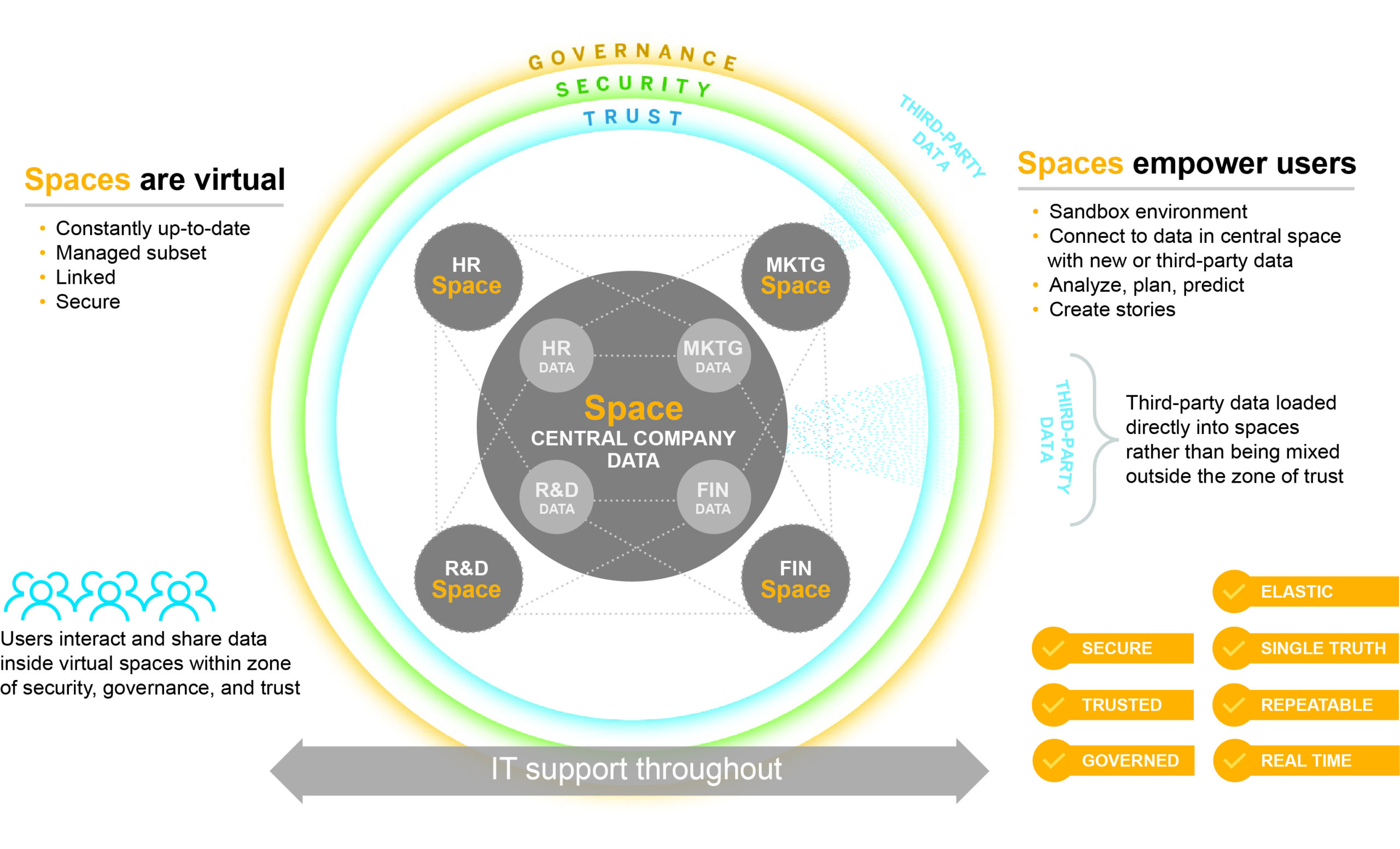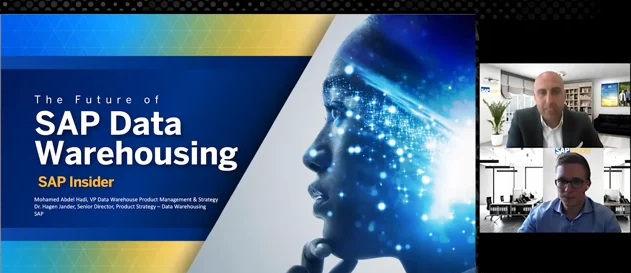Build an Agile Data Platform with SAP Data Warehouse Cloud
Meet the Experts
Meet the Authors
In a rapidly changing business landscape, the ability to adapt by making fast, well-informed decisions is critical. Data is the foundation for the reporting and analytics that are required to support decisions throughout an organization, and businesses need a way to enable access to this data from a variety of heterogeneous locations across their landscapes. This is where data warehouses come in, by serving as a central location of consolidated data.
To help support its customers in this area, SAP provides a portfolio of data warehousing solutions that includes SAP BW/4HANA, SAP HANA for SQL data warehousing, and the latest addition, SAP Data Warehouse Cloud. This most recent addition has many SAP customers — which often already have a data warehouse solution in place — wondering how the new solution fits into their overall SAP landscape. This article walks through some of the most common usage scenarios for SAP Data Warehouse Cloud and outlines the benefits it can provide.
Before diving into the usage scenarios, it will be helpful to clarify the role of SAP Data Warehouse Cloud in SAP’s data warehouse portfolio, and how it works with the other solutions in the portfolio.
Understanding the Role of SAP Data Warehouse Cloud
SAP Data Warehouse Cloud is SAP’s data warehouse offering for the public cloud. It can be used as a standalone data warehouse, and it can also be used as a complementary solution for SAP’s any-premise (on-premise and private cloud) data warehouse solutions, SAP BW/4HANA and SAP HANA for SQL data warehousing (see Figure 1).
Explore related questions

Figure 1 — SAP Data Warehouse Cloud can be used either standalone in the public cloud or as a complementary solution for SAP’s data warehouse portfolio in a hybrid scenario
It is important to understand that SAP Data Warehouse Cloud is not intended to replace existing SAP BW/4HANA or SAP HANA for SQL data warehousing implementations. Instead, it’s intended to complement those solutions via a hybrid approach to enable SAP customers to leverage their already-existing assets and to empower business users with a more flexible and agile environment.
Common Usage Scenarios for SAP Data Warehouse Cloud
There are four common scenarios for using SAP Data Warehouse Cloud:
- Enabling self-services for data modeling and analytics
- Combining data from disparate sources
- Establishing a central semantic layer
- Modernizing your data warehouse
Keep in mind that these scenarios are not mutually exclusive — they are scenarios in which organizations can use SAP Data Warehouse Cloud, and more than one of these scenarios likely applies to any business.
rio 1: Enabling Self-Services for Data Modeling and Analytics
The concept of self-service analytics has been around for quite some time, and organizations continue to try and leverage these capabilities in an increasing number of ways to empower their business users.
So what does “self-service” mean in this context? Let’s look at analytics. From a high-level perspective, for most customers, self-service analytics refers to a scenario where business users are provided with an environment in which they can fulfill most of their requirements themselves, without having to rely on the IT department or a power user to create the analytics for them.
Now let’s take this concept into the data warehousing world. Let’s say that a business user needs information that is partly in the corporate data warehouse — SAP BW/4HANA, for instance — while other parts are stored in local spreadsheets. In this case, the business user typically sends the spreadsheets to the IT team, and the IT team creates a data structure for the information and then uploads the information and combines it with the corporate data warehouse model. What if instead business users could do this themselves, with the ability to enrich data with additional information without creating data models from scratch?
This is where the “spaces” concept from SAP Data Warehouse Cloud comes in (see Figure 2).

Figure 2 — SAP Data Warehouse Cloud includes a “spaces” concept that empowers users to access and enhance information
Spaces in SAP Data Warehouse Cloud allow the IT team to create a dedicated area in which business users can access — in a trusted and governed way — the corporate data warehouse, and bring in additional information from spreadsheets, for instance. Using the visual modeling capabilities in SAP Data Warehouse Cloud, business users can enrich the already-existing data with the added information and then use the newly combined data in SAP Analytics Cloud, without having to rely on the IT team.
In this way, SAP Data Warehouse Cloud — and its spaces concept, in particular — empowers business users and increases the accessibility of relevant information for informed decision making. In addition, it enables IT staff to focus on more critical tasks and continuous improvements.
Scenario 2: Combining Data from Disparate Sources
Nearly every SAP customer has faced the challenge of integrating disparate data sources to avoid “data silos,” and doing so with centralized governance and security to ensure that the integrated information is trustworthy. Those that have a central enterprise data warehouse tend to solve this problem by combining all the information as part of their data warehouse strategy. But what if a more agile and flexible approach is required — one that can quickly react to changes in the data landscape and provide business users with the up-to-date information they need for analytics and decision making?
SAP Data Warehouse Cloud offers unique capabilities that can help meet this need. It provides not only the functionality required to load information from a large variety of SAP and non-SAP data sources, but also the option to enable access to those disparate data sources and use the solution’s visual modeling capabilities to federate those sources — whether the data is acquired via replication or virtually accessed from the sources. SAP Data Warehouse Cloud allows organizations to connect to the data in various sources, without necessarily duplicating the information from the source in SAP Data Warehouse Cloud, and map that together to provide a consistent view.
With the capabilities provided by SAP Data Warehouse Cloud — to virtually access disparate data sources, integrate the information into data models and analytics, and then later decide whether to keep using virtual (remote) access or instead replicate the information into SAP Data Warehouse Cloud — organizations can quickly onboard additional data sources and integrate them into their existing data models (see Figure 3). The ability to simply switch between virtual access or a replicated data approach is unique to SAP Data Warehouse Cloud, and allows SAP customers to quickly get started and later decide on the data materialization, without affecting the data model or analytics.

Figure 3 — SAP Data Warehouse Cloud enables organizations to quickly onboard data sources without affecting the data model or analytics
Scenario 3: Establishing a Central Semantic Layer
The capability described in the previous usage scenario — the ability to combine different data sources and essentially create a “single version of the truth” — is a valuable one. Now imagine adding the ability to create a more business-driven layer on top of that combined data that uses business-friendly terms, hides joining logic, and prepares a set of calculations, all decoupled from the physical data model so the elements are reusable across data sources. This “semantic layer” concept will be familiar to customers using SAP BusinessObjects solutions, and it has now been introduced into SAP Data Warehouse Cloud.
Known as the “business layer” in SAP Data Warehouse Cloud, it provides separation between the physical data model and the semantic model. This allows business users to follow a top-down modeling approach by enabling them to create an abstraction layer from the underlying data model without having to worry about the physical data model. This approach not only allows business users to leverage a more business-oriented abstraction layer, but also encourages strong collaboration between the IT team and business users as well as a common understanding of the data model and the business-oriented view.
The new business layer in SAP Data Warehouse Cloud hides the complexity of data models and combining data and provides a central location for business semantics and key performance indicator (KPI) definitions. This helps avoid redundant and potentially conflicting definitions, and it ensures a common set of definitions for analytics workflows.
Scenario 4: Modernizing Your Data Warehouse
Many SAP customers are currently using SAP BW/4HANA or SAP HANA for SQL data warehousing and seeking ways to modernize their environment to become more agile and flexible. SAP Data Warehouse Cloud complements these offerings to meet these needs via hybrid integration, which allows organizations to reuse their existing on-premise assets while taking advantage of the cloud-based capabilities of SAP Data Warehouse Cloud.
The SAP Data Warehouse Cloud capabilities discussed in the previously outlined scenarios — self-service analytics, combining and onboarding data from a variety of sources, and establishing a central semantic layer — are all part of creating a modernized data warehouse. The ability to reuse assets from an existing on-premise data warehouse as part of this effort enables SAP customers to decide for themselves on the speed of their journey into the cloud.
The integration of SAP Data Warehouse Cloud with SAP BW/4HANA and SAP HANA for SQL data warehousing enables access to all of the capabilities described in the usage scenarios and allows organizations to leverage their existing data warehouses while using SAP Data Warehouse Cloud to provide more agility and flexibility. This approach empowers business users with more self-service analytics and modeling capabilities, creating an environment that allows a rapid reaction to changes and an accelerated time-to-value for information.
Summary
As demonstrated by the four usage scenarios discussed in this article, SAP Data Warehouse Cloud provides SAP customers with several options for creating an agile data platform. Use SAP Data Warehouse Cloud to begin your organization’s cloud journey and to foster a collaborative approach for your overall data strategy that leverages the knowledge of both IT and business users.
Learn More
SAP Data Warehouse Cloud overview
SAP Data Warehouse Cloud onboarding guide
Hybrid integration with SAP BW/4HANA and SAP Data Warehouse Cloud








